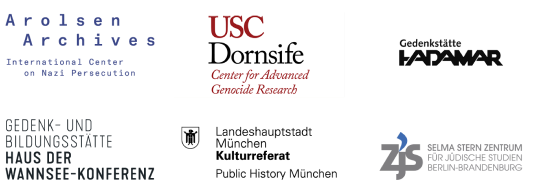Annotations
Eisenach
05/09/1942
At the assembly point in the courtyard of Goethestraße 48, the people persecuted as Jews get ready for marching off. Rabbi Josef Wiesen and a woman are standing next to a cart with luggage. Due to their age, the two were not deported in May 1942, but were sent to the so-called old-age ghetto Theresienstadt in September 1942 instead.
Annotations
People
2
Keywords
2
Historical context
Deportation from Eisenach via Weimar to Bełżyce
The deportation in Eisenach was organized by the criminal investigations police – more particularly by its head, Theodor Meyer. Jewish residents had to present themselves at the assembly point at Goethestraße 48 at an early hour. Around 10:00 a.m. (this time estimate is based on the shadows cast), a photographer commissioned by the town authorities joined the deportees and took pictures of them walking to the train station - along busy streets and through the main entrance.
At 11:06 a.m., these residents of Eisenach boarded the last car of passenger train 2413 – on platform 3. In Weimar, the arriving Jews were taken to the livestock auction hall at the train station, where they were registered and searched.
On May 10, 1942, the 513 men and women from Thuringia boarded a train consisting of "older passenger cars." In Leipzig and Chemnitz, further female passengers were forced to board the train. The train with the official identification DA 27 arrived at Lublin on May 12, 1942 with 1,002 people on board.
No one from Eisenach will survive.
About the image series
In the form of a photo reportage, the series of 20 landscape format photos shows 58 deportees walking across the town to the main train station and boarding 3rd class cars of a regular passenger train to Weimar.
The photographer, who has the habit of almost always taking two photos of the same subject, knows the route the Jews have to take. Sometimes he walks ahead, and at other times he comes very close to the group. Despite the good light, some pictures are blurred.
As he works on behalf of the town authorities, the photographer shows only a marginal interest in the organization and guarding of the deportation. It is for the town's visual chronicle that he shows the Jews marching across the town to the train station and boarding a train. While many Eisenach inhabitants are pictured watching the marching column, guards are only shown on the periphery.
Photographer
Theodor Harder, Photographer
Theodor Harder ran a studio and a photographic workshop at Karlsstraße 6 in Eisenach. It is certain that he cooperated with the town authorities and also published photos in the Thüringer Gauzeitung (a regional newspaper in Thuringia).
Provenance
The picture series was probably pasted into the town's visual chronicle – which the town archives started to keep in 1935 – shortly after the pictures were taken.
Due to the great demand from academic publications and exhibitions, the photos were removed from the pages of the chronicle in the early 1990s and have been kept as individual photos since then.
The photos are original prints on Agfa postcard paper with deckle edge in oblong format.
Call number at source archive
41.3-J-483
Title at source archive
Ohne Titel
Acknowledgements
We would like to thank the staff of Stadtarchiv Eisenach for supporting the research and the project.
Text and research by Christoph Kreutzmüller.
Kooperationsverbund #LastSeen. Bilder der NS-Deportationen Dr. Alina Bothe Projektleiterin
c/o Selma Stern Zentrum für Jüdische Studien Berlin-Brandenburg
Freie Universität Berlin
Habelschwerdter Allee 34A
14195 Berlin
lastseen@zedat.fu-berlin.de
Ein Kooperationsprojekt von

Gefördert durch

Datenschutz | Impressum